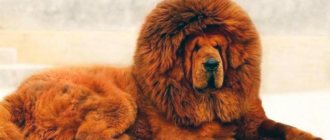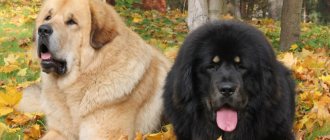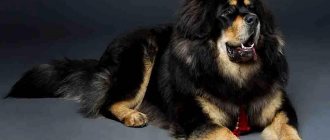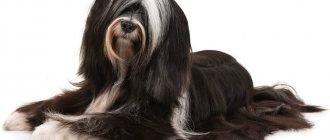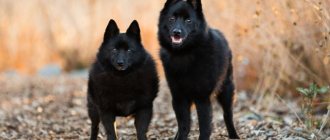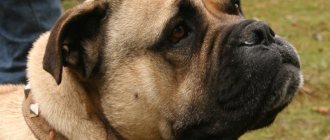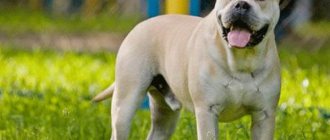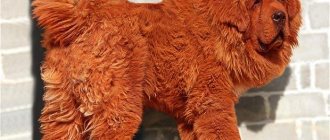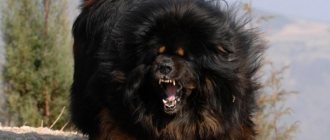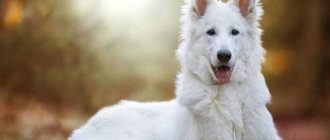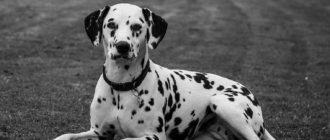What a Tibetan Mastiff is, the characteristics of the breed, the basic rules regarding care and maintenance are important topics that need to be carefully studied before deciding to buy such a dog. A huge animal can become a good friend and guard.
Tibetan Shepherd: description of the breed
The Tibetan Shepherd or Tibetan Mastiff is an excellent guard dog. These are strong animals, with a height of 60-65 cm reaching a weight of 60-70 kg.
The breed is famous for its thick coat with a double undercoat, which perfectly protects the animal in winter. The thick hair in the neck area visually resembles a mane, which is why the Tibetan Shepherd Dog has the nickname “Tibetan lion”.
The coat color varies from gray-blue to deep black. There are also individuals with various red shades. There are white areas on the chest and paws.
Origin story
The Tibetan Mastiff has been surrounded by myths and legends since ancient times. The breed itself is quite ancient, formed as a result of the geographical isolation of Tibet.
Since the 13th century, when Chinese merchants passed through the territory of Tibet, the gene pool of local and Chinese dogs began to mix. Purebred Tibetan dogs remain only among those living in the mountains.
The first mentions of these strong and hardy animals begin to appear centuries BC. In the 13th century, during his travels to Asia, Marco Polo described these dogs admiringly. They were brought to Europe in 1847.
Tibetan mastiffs amazed European residents with their appearance, which is why the first individuals brought there were kept in zoos.
Many dog handlers study Tibetan mastiffs with interest. Some of them even express the opinion that this breed can be considered the ancestor of the Molosser (this is a group of dog breeds that includes Great Danes, Bulldogs, Mastiffs, Boxers, Pugs).
Price
The cost of a puppy purchased from a nursery will be approximately fifty thousand rubles. Ads that list a significantly lower price are most likely asking you to purchase a mixed breed. Whether the money saved is worth the risk of bringing a huge animal of unknown origin into your home is up to you to decide. If purebred specimens are studied and characterized by dog handlers, and trainers from the same nursery can approach them, then no one can predict how a mestizo will grow up.
Show breed standards
The breed standards for the Tibetan Mastiff are not spelled out in much detail.
Some individuals within the breed differ markedly from each other in color and size. The minimum height for males is 66 cm, for females - 61. Different variations in color are allowed: black, gold, chestnut, red and gray with tan.
The Tibetan Shepherd (photo) is the largest dog of all the ancient breeds on Earth. She has a powerful muscular body, a strong neck with a slight bend and mane, strong, evenly placed limbs. The tail is of medium length, set above the level of the back line, curved. The head is wide, with a massive and strong skull. The ratio of skull to muzzle is 1:1.
The eyes are medium-sized, far apart, expressive. The ears are drooping, triangular in shape, low set and close to the head.
Character
The character of the Tibetan Shepherd harmoniously combines patience and fearlessness, which makes it an ideal home protector. However, like every breed, it also has its own behavioral characteristics that future owners should take into account.
The character of the Tibetan Mastiff is sometimes distinguished by stubbornness and independence, so it is very important that the dog, from puppyhood, learns not only to obey, but also to trust its owner.
The Tibetan Shepherd (photo in the article) loves communication and attention, so it is perfect for keeping in a family. Despite their patient nature, it is better not to let small children near the animal, because overly active behavior typical of children can be mistaken by a guard dog for aggression against itself.
Tibetan mastiffs also do not approve of large gatherings of strangers in the house. Therefore, lovers of noisy and crowded parties should not get a dog of this breed. This attitude is typical for all breeds of dogs with guarding qualities.
During walks, it is necessary to adhere to different routes, otherwise the mastiff will consider someone else’s territory to be its “protection zone.”
If a Tibetan Shepherd dog is kept in the yard most of the time, it is necessary to fence the area with a fairly high fence.
It is not recommended to leave the Tibetan Mastiff alone for a long time or with unfamiliar people. A naturally sociable dog can harbor a grudge and stop trusting its owners, or even go wild.
Good or evil?
In appearance, the breed really inspires horror, looks stern and even embittered . Sometimes it seems that they suspect everyone they meet and will do everything possible to ward off a potential troublemaker from the owner.
The mastiff is scary not only with its appearance, but also with its voice.
The animal has a rather specific bark with a special range . This is due to the power of the chest and extensive lungs, which sharply push air into the larynx.
However, this breed only looks angry.
The Tibetan Mastiff is famous for its balanced character, ready to remain calm even in critical situations, provided that the safety of its own family is not at stake, which the dog treats with trepidation. Therefore, it is not surprising that the dog is able to appear both in the role of a protector and in the role of a nanny.
The mastiff has a special relationship with children.
Features of care and maintenance
Given the size and character of the Tibetan Mastiff, it is best to keep it in the spacious yard of a private house, where it can play and move around to its heart's content.
The thick double undercoat creates certain difficulties for keeping the animal in a hot and humid climate. The Tibetan Shepherd Dog tolerates high temperatures well only when kept in a dry climate.
Every day it is necessary to provide the dog with walks and active games lasting at least half an hour. When walking with a puppy, the owner must be extremely attentive and careful. The fact is that it is during the period of growing up that most limb injuries occur, so outdoor games with a small mastiff are best spent in familiar terrain, for example, in the yard of a house.
The Tibetan Mastiff usually sheds once a year, depending on the climate. The dog must be brushed several times a week with a special grooming brush. Tangles need to be untangled by hand or cut off. Bathing is carried out once a month and as needed.
Proper and timely care will ensure a long and healthy life for your pet.
Health and illness
Owners should remember that most infectious diseases can be avoided by vaccinating their pet in advance. These procedures must be repeated annually, with revaccination at the veterinary clinic.
The Tibetan Shepherd does not suffer from diseases specific to its breed. The most common condition in dogs, including Tibetan Mastiffs, is entropion, where the lower part of the eye rolls inward. This problem can be solved relatively easily, with the help of simple surgery.
Large dogs often have joint problems, and although Tibetan Shepherds are not particularly susceptible to this disease, no one is immune to the risk of hip dysplasia. To prevent the disease, it is recommended to conduct x-ray examinations from time to time (but not more than once a year), and also carefully monitor the visual manifestations of possible diseases.
Proper nutrition of the Tibetan Shepherd
The Tibetan Shepherd, especially during the period of active maturation, eats a lot. Adult dogs need less food, but their diet should be balanced.
It is not recommended to mix ready-made dry food with natural food. A complete diet should include cereals, eggs, vegetables and meat.
Feeding should be done at regular intervals. Puppies up to six months of age should eat at least six times a day, adults - up to four times.
Basic nutritional rules to follow:
- You cannot overfeed your dog. If for some reason she is very hungry, it is necessary to provide more frequent feeding in small portions.
- Do not soak dry food in water or milk. This may lead to poisoning.
- A sudden change of food from natural food to ready-made dry food can cause digestive problems, so such a transition must be carried out gradually.
- It is necessary to choose food for your pet taking into account its age.
- Smoked, salty foods, raw fish and meat should not be given to animals.
Conditions of detention
Despite the high cost of mastiff puppies, starting from 50,000 rubles, the popularity of this breed is very high. The advantages of dogs include:
- impressive appearance, luxurious long hair visually increases the already small size of the dog, and the thick lion's mane is a distinctive feature of the breed;
- unpretentiousness and disease resistance;
- calm character and strong psyche;
- good security qualities;
- Despite its size, an adult mastiff eats little; 400-600 g of food per day is enough for him.
The difficulties of the breed include:
- loud, booming bark that can disturb others;
- thick coat that needs to be carefully groomed;
- you need a lot of space for walking.
Due to the large size of the dog (males reach a height of 70 cm at the withers, weight over 80 kg), keeping a pet in an apartment can cause some difficulties. Mastiffs are used to living freely and moving a lot, so they can be kept outside. In an apartment, you will have to take a lot of active walks with your pet, at least three times a day. The mastiff should have enough room in the room to comfortably stretch out while sleeping.
Keeping a mastiff outside is not difficult. He doesn’t even need a kennel - the luxurious wool perfectly protects the dog from the cold. But a good sun canopy in the enclosure is necessary. In hot weather, the mastiff needs to be in the shade so as not to overheat.
DIY enclosure for a mastiff
An enclosure for such a large and powerful dog must be reliable and strong. The fence consists of metal pipes dug into the ground and a strong mesh attached to them. The height of the fence should be at least 2 m. Despite its apparent slowness, the Tibetan mastiff is a very active animal, capable of easily jumping over a one and a half meter fence. For reliability, support pillars are dug to a depth of 40-60 cm and concreted. It is not practical to leave bare soil in the enclosure. When it rains and snow melts, the paddock will be dirty. The surface of the earth should be covered with coarse sand, a layer of at least 30 cm. It can be covered with boards. A more expensive but convenient option is special rubberized mats.
There is no need to build a booth for the Tibetan mastiff. A raised wooden deck measuring at least 3 m by 3 m, protected from the wind on three sides by plank walls, is sufficient. A roof over part of the enclosure is a must.
No matter how large and comfortable the enclosure is, the dog should not be in it all the time! Close contact with humans is very important for the mastiff. A dog locked alone will suffer.
Training
In order for a dog to be obedient, it is necessary to train it, starting from puppyhood.
The Tibetan Shepherd is a naturally intelligent and attentive dog that needs guidance and a firm hand from its owner. However, training must be carried out in such a way that the animal learns not only to obey, but also to completely trust the owner, therefore screaming or violence is unacceptable. Under no circumstances should the puppy’s natural playfulness be suppressed, otherwise he will experience a hidden fear of his owner, which may result in uncontrollable behavior in the future.
Tibetan Shepherds, like most guard breeds, need socialization - from time to time you need to introduce them to other people and dogs. If an animal is deprived of socialization, it may become overly aggressive and suspicious. Of course, in this case it is necessary to observe the golden mean - the dog should not forget about its security duties.
If an animal shows unreasonable aggression, it is necessary to seek clarification from professional dog handlers and trainers. Being practically familiar with the characteristics inherent in a particular breed, they will be able to most likely determine the reasons for this behavior of the mastiff.
Owner reviews
A few reviews:
“One day on New Year’s Eve, my godfather came and brought a small bright red lump that looked like a bear cub. This was our Rambo. Naturally, while the puppy was growing up, he chewed everything he could reach. Now he is already six years old and is a very serious and respectable dog. He is very smart and understands everything.”
“Why didn’t anyone tell me that mastiffs love to dig so much? Darkness is a wonderful dog, obedient, trained, but when he gets to my garden I can only clutch my head and sob. It's just a mini tractor."
Tibetan Mastiff and Caucasian Shepherd: comparison
When planning to purchase a guard dog, many future owners are faced with the choice of adopting a Tibetan Mastiff or Caucasian Shepherd puppy. Both breeds have excellent guarding qualities, but it is also necessary to take into account the specific character traits inherent in each of them.
The Caucasian Shepherd is more difficult to train, so inexperienced dog owners are better off choosing the Tibetan Mastiff. What other significant difference between them? The Caucasian Shepherd Dog versus the Tibetan Mastiff is distinguished by a more cocky and cunning disposition, while the Tibetans are more docile and calm.
Of course, the character of a dog will depend not only on its belonging to a particular breed. What matters is the upbringing and psychophysical qualities of each individual individual acquired from birth, which cannot be predicted with one hundred percent probability.
Pros and cons of the breed
Purebred Tibetan Mastiffs are more expensive than other breeds on the planet. Before spending money, you need to think about all the positive and negative qualities of the animal and compare them with your own capabilities.
Positive qualities include the following:
- Remarkable guarding skills of the Tibetan Mastiff.
- Character – dogs are friendly and kind to their charges.
- They are undemanding to a high level of living conditions and nutrition - but this does not mean that it is completely unnecessary to pay attention to them. Otherwise the dog will get sick.
- Independence.
- Cold resistance.
Negative qualities:
- Unsuitability for living in an apartment due to its size.
- Stubbornness.
- A strong voice and a love for using it.
- Shedding.
Even though there are more pros than cons, the latter may be more significant in some living conditions.
